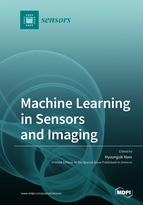Machine Learning in Sensors and Imaging
A special issue of Sensors (ISSN 1424-8220). This special issue belongs to the section "Sensing and Imaging".
Deadline for manuscript submissions: closed (10 January 2022) | Viewed by 60806
Special Issue Editor
Interests: display electronics; low power; machine learning; UI/UX
Special Issues, Collections and Topics in MDPI journals
Special Issue Information
Dear Colleagues,
Machine learning keeps extending its applications in various fields, such as image processing, the Internet of Things, user interface, big data, manufacturing, management, and so on. In particular, because data are required to build machine learning networks, sensors are one of most important technologies. In addition, machine learning networks can contribute to the improvement of sensor performances and the creation of new sensor applications. This Special Issue is addressed at all types of machine learning applications related to sensors and imaging.
Topics of interest may include but are not limited to the following:
- Machine learning for improving sensor performance;
- New sensor appications using machine learning;
- Machine-learning-based HCI;
- Machine-learning-based localization and object tracking;
- Machine learing for sensor signal processing;
- Machine-learning-based analysis on the big data collected from sensors.
Dr. Hyoungsik Nam
Guest Editor
Manuscript Submission Information
Manuscripts should be submitted online at www.mdpi.com by registering and logging in to this website. Once you are registered, click here to go to the submission form. Manuscripts can be submitted until the deadline. All submissions that pass pre-check are peer-reviewed. Accepted papers will be published continuously in the journal (as soon as accepted) and will be listed together on the special issue website. Research articles, review articles as well as short communications are invited. For planned papers, a title and short abstract (about 100 words) can be sent to the Editorial Office for announcement on this website.
Submitted manuscripts should not have been published previously, nor be under consideration for publication elsewhere (except conference proceedings papers). All manuscripts are thoroughly refereed through a single-blind peer-review process. A guide for authors and other relevant information for submission of manuscripts is available on the Instructions for Authors page. Sensors is an international peer-reviewed open access semimonthly journal published by MDPI.
Please visit the Instructions for Authors page before submitting a manuscript. The Article Processing Charge (APC) for publication in this open access journal is 2600 CHF (Swiss Francs). Submitted papers should be well formatted and use good English. Authors may use MDPI's English editing service prior to publication or during author revisions.
Related Special Issue
- Machine Learning in Sensors and Imaging II in Sensors (2 articles)







